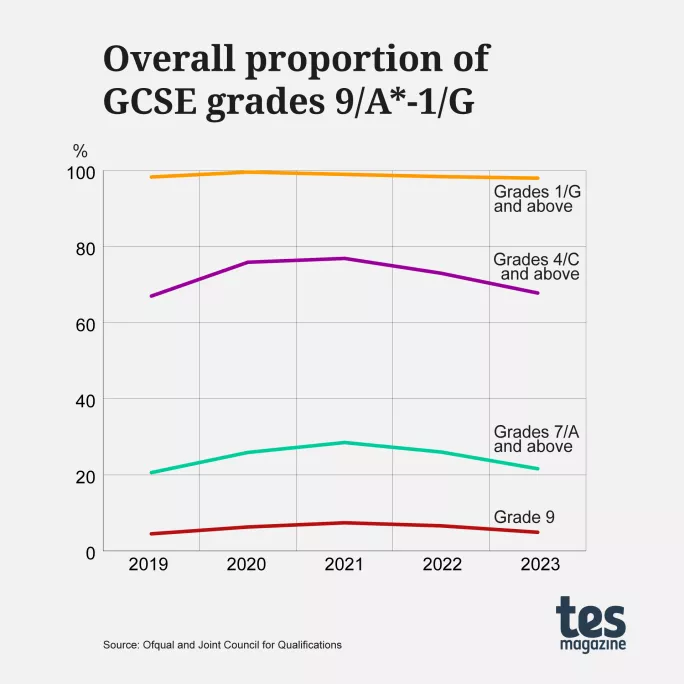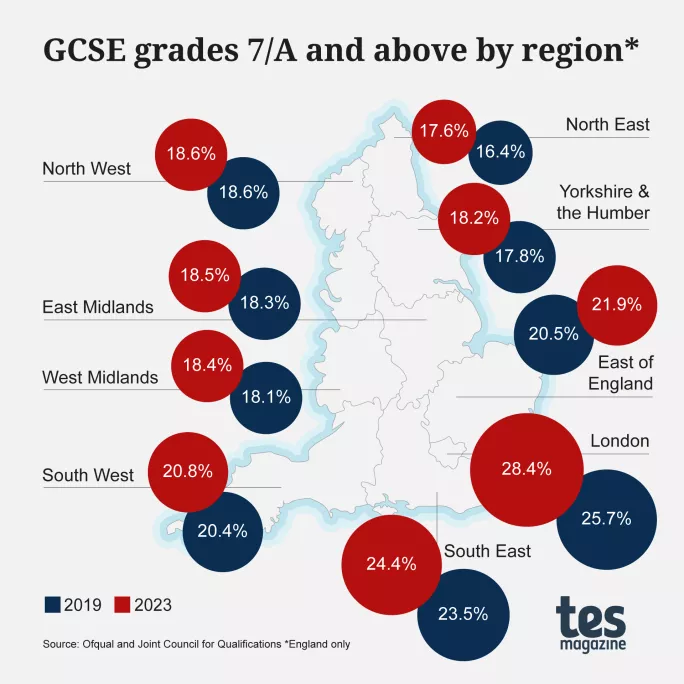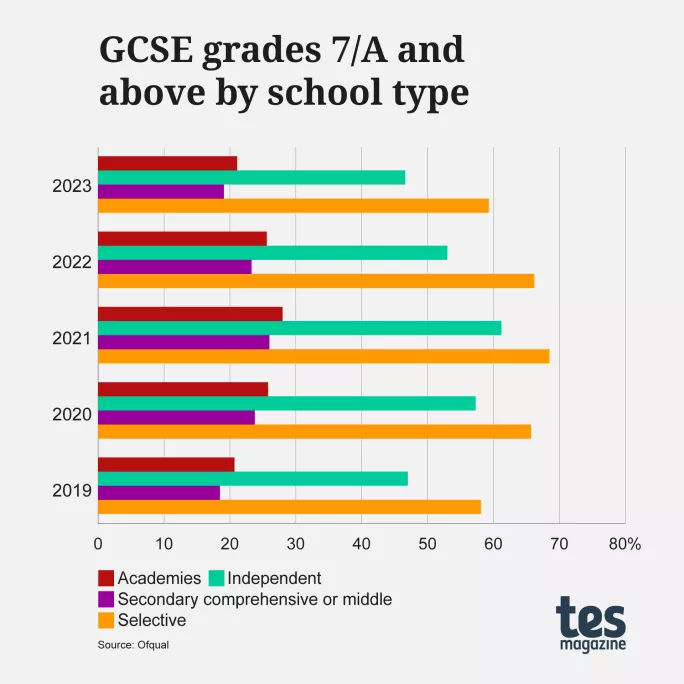GCSE results 2023: Attainment gap widens after grading reset

GCSE results were released this morning in England, revealing a wider attainment gap between the North and the South than before the pandemic.
However, the proportion of top grades achieved by students at private schools fell slightly from 2019 levels - in contrast with all other school types, where the proportion of students achieving top marks was slightly up on pre-pandemic levels, as expected.
The results, which also reveal an expected fall in the overall proportion of top grades awarded this year, show that while girls have continued to outperform boys, the gender gap has decreased slightly.
This summer, students sat GCSE exams for the second year following the cancellation of exams in 2020 and 2021 owing to the pandemic.
The government and Ofqual have overseen a return to pre-pandemic grading this year, with “some protection against any impact of Covid disruption”.
Here are the headline figures for today’s GCSE results.
Not in England? Here’s all the latest on GCSE results around the UK:
GCSE 2023 results drop towards 2019 levels
Overall, the proportion of entries graded 7/A or above was 21.6 per cent. This is 4.4 percentage points lower than last year’s figure, but still slightly above the 20.6 per cent of entries that received a 7/A grade or above in 2019.

The proportion of entries graded 9/A* was 4.9 per cent this year, down from 6.6 per cent in 2022 but up from 4.5 per cent in 2019.
At grade 4/C, there was a fall of 5.2 percentage points on last year, with 67.8 per cent of entries awarded this grade or above compared with 73 per cent in 2022 and 67 per cent in 2019.
And at grades 1/G and above, the proportion of entries was 98 per cent, a fall from 98.4 per cent last year and slightly below 2019‘s figure of 98.3 per cent.
Looking for GCSE results by subject? You’ll find our detailed breakdown here.
North-South gap widens at GCSE
This year’s results reveal that, as in 2019, the North East region received the lowest proportion of GCSE grades at 7/A or above (17.6 per cent), while London received the highest proportion (28.4 per cent).
This difference has widened to 10.8 percentage points this year, up from 9.3 per cent in 2019, when 16.4 per cent of entries in the North East received the top grades compared with 25.7 per cent of entries in London.
The data prompted one sector leader to accuse the government’s catch-up initiatives of being “too London-centric”.
Chris Zarraga, director of Schools North East, said that “perhaps schools in London have been better placed to use tuition compared with a region like ours where the take-up has been much lower and where the infrastructure is not in place”.

The data also shows that the gap between the South East (the second-highest performing region) and the North East has shrunk slightly since before the pandemic, from 7.1 percentage points in 2019 (when 16.4 per cent of entries received top grades in the North East compared with 23.5 per cent in the South East) to 6.8 percentage points this year (with the figures standing at 17.6 per cent in the North East and 24.4 per cent in the South East).
Last year, when exams were held for the first time after two years of cancellations, it emerged that the attainment gap between regions in the North and South of England had widened since students had last sat them.

In 2022, the gap between the North East and Yorkshire and the Humber, which jointly received the lowest proportion of GCSE grades at 7/A or above (22.4 per cent), and London, which received the highest proportion (32.6 per cent), was 10.2 percentage points.
This year, the attainment gap widened most between the North West and London, with the gap growing by 2.7 percentage points since 2019.
Girls still outperforming boys at GCSE
In 2023, girls continued to outperform boys, but the gender gap at grades 7/A and above has decreased slightly, having shrunk by 1.4 percentage points since 2022.
In total, 25.3 per cent of entries from girls were awarded the top three grades compared with 19.5 per cent of entries from boys, making the gender gap 5.8 percentage points.

The gender gap has also decreased slightly at grades 4/C and above, with 66.9 per cent of entries from boys and 73.7 per cent of entries from girls achieving a GCSE pass - a gap of 6.8 percentage points, compared with 7 percentage points last year.
GCSE grade gap between private and state schools narrows
In 2023, the proportion of students achieving a grade 7/A and above in private schools was 46.6 per cent, slightly below the 2019 figure of 47 per cent.
And this year’s figure is 6.4 percentage points lower than 2022’s (53 per cent).
However, in secondary comprehensive schools, this drop was smaller (4.2 percentage points) as grades fell from 23.3 per cent in 2022 to 19.1 per cent this year.
This means the attainment gap between private schools and secondary comprehensives was 27.5 percentage points, slightly below the 2019 figure of 28.5 percentage points.

In 2022, private school students also recorded a larger year-on-year drop in top GCSE grades than did state school students.
The proportion of entries awarded a grade 7/A or above at private schools last year - the first year of exams resuming after the pandemic - was 53 per cent, 8.2 percentage points lower than the figure in 2021 (when final marks were determined by teacher-assessed grades), which was 61.2 per cent.
Meanwhile, this year, 21.1 per cent of academy entries and 59.3 per cent of selective school entries achieved top grades, compared with 20.7 per cent and 58.1 per cent, respectively, in 2019.
In secondary modern schools, sixth-form colleges and further education establishments, grades were slightly above 2019 levels in 2023.
A rise in resits and other trends
The number of students needing to resit English and maths has increased since 2022. That number does, however, remain lower than the total number of students who had to resit papers in 2019.
The popularity of subjects remains unchanged, with double science, maths and English still proving to be students’ top three options.
Read more: 10 key insights from GCSE results
What GCSE students have been through - and what’s next
Those who sat their GCSEs this summer were subject to multiple phases of home learning during the pandemic - and have faced further disruption this year as a result of teacher shortages and industrial action.
Read our report on the disruption that GCSE students have suffered here.
Appeals
If a school or student believes that a mistake has been made with the marking of an exam or with the administration process, it is possible to appeal to see the exam paper and have it checked by another examiner.
GCSE resits
Resits are available for any GCSE exam if desired. However, it is a requirement for any student who receives a grade lower than a 4 in English or maths to retake the exam.
How can schools support GCSE students?
Whether students are celebrating their results or having to remake their plans, they will likely benefit from seeing familiar faces to share the experience with them. There are plenty of ways teachers can help out, as detailed in the following articles:
- For classroom teachers: The role of the teacher on GCSE results day
- For middle leaders: A head of department’s guide to results day
- For pastoral leaders: How to support students who miss their grades
topics in this article



